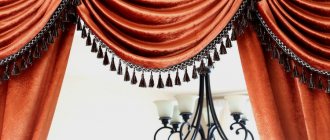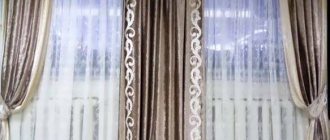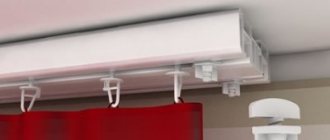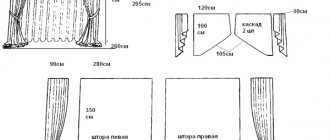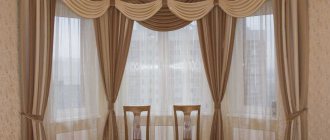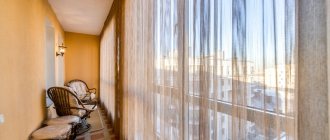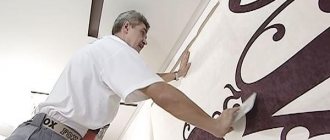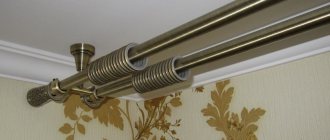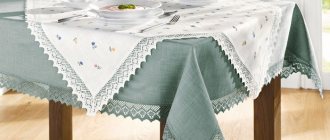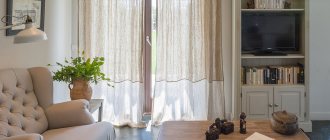The installation of a well-known decorative element for premises - a lambrequin - is known to almost all housewives. With the help of a lambrequin you can hide the unattractiveness of the cornice, as well as visually enlarge the room in which it is located. How to hang a lambrequin quickly and with minimal effort? The reader will find out the answer to this question by reading the article to the end.
Varieties of lambrequins
The product is a rectangular piece of fabric that is attached to the curtain rod on top of the curtain. Even a novice master can handle sewing.
Enough:
- Measure the width of the window opening or the length of the cornice.
- Increase the resulting figure by at least 30% (to get a beautiful assembly).
- Cut out 2 rectangles - for the front and back sides of the lambrequin.
- Sew the resulting parts together.
However, there are other decorative elements.
Soft
Lambrequins are pieces of fabric gathered into soft folds. This is a whole group of products that can differ in styles and sizes.
Such models are hung with fairly thick curtains in spacious rooms with high ceilings. But if you choose the right product, they also look good in a room with a standard ceiling height.
Hard
If soft lambrequins, like curtains, regulate the penetration of sunlight into a room, then hard models perform mainly a decorative function. They are sewn straight, without folds. Often they are an openwork ribbon made in a factory.
But the simplest rectangular models - “bandeau”, resembling a wide ribbon, are glued from the inside with a special material - doublerin.
Combined
This type of lambrequins is a combination of individual elements of soft products with hard ones. Models can be complemented with decorative cords, tassels and other accessories.
How to expand the space and raise the ceiling
Designers claim that experiments with installing lambrequins can only be done if the ceiling in the room is not below 2.7 m, and if the room is spacious enough, otherwise curtains with such decorative elements will visually make it more bulky.
The lambrequin should be hung so that its upper part coincides exactly in the middle with the line of the window opening. At the same time, it is advisable to raise the edges of the canvas a little. These secrets will help you achieve the effect of a window smile. You need to carefully fasten it, because low edges will visually lower the ceiling. Often designers recommend using active vertical lines in the design. To do this, you need to make folds 0.5-1 m wide, falling evenly to the floor. The volume of drapery is selected depending on the size of the window opening. It is advisable to purchase curtains that will have a brighter color palette than the lambrequin. You can also use a fabric with contrasting color. This will also visually lift the space.
The lambrequin can be easily stylized. It is not necessary to use the classic version, and then it can fit even into an ultra-modern interior. In a high-tech style, the role of a decorative structure will be well fulfilled by a raised blind - this is what is commonly called in the design world for an ordinary Roman or roller blind. A few fancy valances will help you achieve layering without being too pompous. Design techniques for a stylized design are no different from those used for the classic version. If the canvas is mounted high, the height of the walls and windows will visually increase. If you make the roller blind wide, protruding far beyond the side walls of the window, the boundaries of the opening will expand.
Types of soft
In the interior of residential premises, soft curtains are often used. There are many varieties of them, and it is easy for owners to choose the most suitable option.
Swags
They are semicircular parts assembled into slightly sagging drapery elements. They are attached to the cornice using curtain tape, which makes it easier to assemble the folds.
Swags are used in interiors decorated in a classical style; they are not suitable for minimalism.
Step-by-step sewing of a swag looks like this:
- First they take measurements. You need to know the width and height of the window opening, the length of the cornice.
- Make a calculation. For swag, such indicators as depth (the degree of sagging of the drapery), length (the segment that the product will occupy on the cornice), shoulder (side part) are important. The most popular are equilateral swags, both arms of which are the same length.
- They build a swag pattern taking into account its shape. For an equilateral element, the pattern is made based on a square.
- Cut out the product blank, taking into account seam allowances.
- The parts of the swag are sewn together taking into account the characteristics of the fabric from which it is made.
Tie
This element is also called déjabot, or frill. It is a vertical drapery of a spiral shape. This lambrequin resembles an old tie that can be seen in historical portraits. It can be cascading or helical, with counter folds. "Ties" can be combined with swags.
Coquille
The element is often associated with women's dresses or blouses, but lambrequins can also have this shape. This is a strongly flared circle or oval, which is cut out in a spiral, carefully working out the edges. Both single and double molds look beautiful.
Buffs
The window decor element is a piece of fabric that forms three-dimensional assemblies of various shapes. They are secured using hand or machine stitching.
Bell
This is not a full-fledged lambrequin, but a detail of window decoration - a small element with draperies reminiscent of a bell.
Combination with different curtains: the most beautiful ideas
The hall differs from other rooms in its large size. It has room to use all your fantasies regarding its decoration, so you can choose the most beautiful and original window design variations. Guests are often received in this room and family gathers for relaxation, so it is so important to create coziness and comfort here. Various photos of curtains for the hall can be viewed at the link.
It is worth opting for decent luxurious fabrics, both for upholstery and curtains, so that the room takes on a sophisticated look.
Lambrequins will be the final decoration of this room. They must be chosen after furnishing the entire room, so that they complement and emphasize everything planned without disturbing the created harmony. There are two options for using a lambrequin: with curtains or with tulle. Lambrequins are a classic design of curtains for a large window.
Togas curtains are of excellent quality and a variety of colors.
Here you will find a video about installing roller blinds on a plastic window.
Photo curtains with photo printing with 3D effect: .
With curtains
When decorating a window in a hall, the chosen cornice plays a huge role. It depends on its appearance and material of manufacture which curtains and finishing to choose for them. Lambrequins should complement the window composition, become its continuation, so you should take into account some rules when choosing them:
- choose fabrics with a similar texture for them and for curtains;
- use compatible colors;
- maintain proportions and symmetry.
The fabric for lambrequins can be the same from which the curtains are made, it can be lighter or denser. The colors of the fabric should be in harmony with the upholstery, carpets and curtains. Usually they settle on a symmetrical window design and arrange all additional elements for decoration in proportion.
If you still decide to use asymmetry, then it is better to turn to professional designers so that the end result does not disappoint expectations. They will not only advise how best to do this, but will also help bring all the planned combinations to life.
The length of the lambrequin affects the overall appearance of the structure. Using it, you can adjust the perception of the appearance of window or door openings, make them wider or narrower, or change the height. It is customary to take as a standard a lambrequin width that is 5-6 times smaller than the curtains themselves, but this is an approximate ratio; the final decision must be made based on the conditions in the living room. The larger this room, the more massive and heavy the lambrequins can be made, and vice versa.
For a majestic large hall, they choose decorations made of fringe, ties or frills, thereby achieving luxury and pomposity.
But this is impossible for a room in light colors; in it, such decorative elements will look tasteless and rude. Light soft lambrequins are suitable here. For a small room with small windows, a pile of folds of dense fabric should be excluded; a simple type of lambrequin on a dense base should be used, which will act as a wide cornice. Photos of curtains for a small window can be seen here.
The video shows more information about lambrequins and their types:
Tulle with lambrequins
You can often find windows curtained with one type of curtain, such as curtains. But without curtains they look lonely and simple, so they usually go in tandem with lambrequins. Due to the lightness and airiness they create, they are suitable for living rooms of any size. You should choose the color of fabric for lambrequins and curtains in different shades. Monochromatic compositions look dull.
The color range can vary from milky to rich bright colors. The lighter tone will act as the base or background. A contrasting or bright central color is selected, which should succinctly fit into the decor of the room. There are many combinations of curtains and lambrequins, with a selection of different fabric textures and additional elements for decoration.
On the video there are photos of new and classic lambrequins:
A combination of thick velvet lambrequin and airy floor-length tulle is appropriate. Often there is a combination of soft folded lambrequins and tulle attached to a decorative rod, which makes the decoration complete. For the romantic style of the room, lace is used; it can be sewn in several layers, then through it daylight will acquire a charming effect.
Patterned curtains are well complemented by lambrequins with similar motifs, which will be repeated several times on the canvas (floral motifs with floral arrangements).
Types of hard
The structures are made using different techniques. They are often a factory-made product, but sometimes they are also made at home.
Openwork
The simplest option is an openwork stripe. Sometimes an intricate pattern is cut into it using a laser. In this case, the drawing can be made in any style. Such lambrequins are made from lace, denser fabric, incl. felt.
With a straight, curly edge
Basically we are talking about strip, or strip, lambrequins. Such models can be hung even in rooms with low ceiling heights. They are often made from coupon roll material, with a pattern repeated along the entire length.
Cut the products in the form of 2 rectangles of the same length, leaving seam allowances on each. Separately, cut out a rectangle from cushioning material - doublerin or non-woven fabric with an adhesive base, which will help fix the rigid shape. Such lambrequins do not form folds.
In addition, there are plank structures made of rolled material with a curved edge - they look impressive.
Results
Elegant window decoration
As you can see, the process of attaching a lambrequin is not that complicated. The result will undoubtedly please you, because thanks to the lambrequin an atmosphere of warmth and comfort is created in the room.
A beautifully designed window space looks original and attractive compared to standard curtains and tulle. The main thing is to successfully choose the fabric, color and design of the product, because it is thanks to this that you will achieve maximum harmony.
For example, high fastening of the structure will visually lengthen the height of ceilings and walls, while a wide product will expand the boundaries.
We wish you success and successful experiments. The video in this article will clearly depict the entire process of attaching a lambrequin.
Window decoration is a special art. In order to create a cozy homely atmosphere, it is necessary to combine many elements that will not only complement each other and harmoniously combine with the existing interior, but also perform a special function.
Thick curtains protect the room from prying eyes, airy curtains help daylight penetrate inside, and a lambrequin most often helps to hide some imperfections and, of course, performs a special decorative function. Today we’ll talk about how to hang a lambrequin correctly.
Choosing a cornice for a lambrequin
For any product it is important to choose the right cornice. In this case, the same elements are selected as for curtains, i.e. they are wall and ceiling.
In each of the categories, several additional varieties can be distinguished. For example, there are profile cornices, “rod” models and strings. The latter are rarely used for attaching lambrequins, especially when it comes to lush, soft models such as swags, molds or puffs.
More often, either ceiling cornices hidden behind the plank or round rods are used.
General recommendations for securing drapery
Product made from durable materials
Apartment decoration: curtain design + tulle + cornice + lambrequin - all these concepts are interconnected, because they relate to the design of the room. As mentioned above, window decoration plays a major role in this process, so it is extremely important to correctly select all the necessary elements and details.
So, for example, if there are curtains, then the presence of a rigid lambrequin is implied. In addition to this, there are also soft and combined ones.
The decorative lambrequin for the cornice is mainly made from the same fabrics that are used when sewing porter or companion fabrics. Products made from lightweight materials - organza or transparent veil - look most attractive. Tiebacks, decorative cords, pompoms, tassels - all these accessories complete the composition.
Labrequin - a true decoration of curtains
Cornice installation process
How to attach a lambrequin to a cornice - this is a question that arises for all those who decorate a window on their own. First of all, we would like to note that the product is fastened to special cornice guides.
Note! Attaching drapery to the cornice is not an easy task. Buying a lambrequin or ordering one according to your own design is nothing compared to installing it. Therefore, if you are not confident that you can handle this process yourself, it is better to seek help from professionals.
How to attach a lambrequin to a cornice
This decorative element must be properly fixed, otherwise the calculations and efforts to manufacture the product will be in vain.
Velcro
To fix rigid structures, special Velcro is used. In this case, you need to measure the tape along the upper border of the lambrequin. It is fixed with the sticky side to the outer edge, and a special adhesive composition is used on the inside.
Tapes with loops
Tapes or loops can be used for lambrequins. The first ones are strips of the same fabric from which the curtains themselves are sewn. They can be tied in different ways, incl. bows, attach to the cornice using loops sewn from the same fabric as the lambrequin.
Peculiarities
Before you become familiar with the methods of attaching lambrequins, you need to understand what these products are. Textiles are one of the decorative elements of drapery. Basically, lambrequins are located in a horizontal position on top of the curtains.
The products are used on massive thick curtains that decorate spacious rooms.
Often, various elements are used to decorate the lambrequins themselves. These include:
Most often, textile products are used as a complement to classic interiors. It is known that this trend is pretentious and loves various decorative elements that can fully emphasize the expensive furnishings.
Today there are several main types of lambrequins:
- The most popular options include soft models that are easy to attach. Basically, the same fabric from which other window design elements are made is used for sewing. These lambrequins are attached to curtains or cornices.
- But rigid lambrequins need a strong frame for fixation. For more convenient fastening, an element such as Velcro is used.
- A universal type can be called combined models that combine the features of the two previous options. In this case, soft elements are used as a complement to the hard base.
How to hang a lambrequin on a cornice
This depends on both the type of fabric and the type of cornice.
To the ceiling
Adhesive tape is most often used. For reliability, it is coated with glue on the inner (soft) side: this way it will be attached to the underside of the drapery. You can use clear fishing line instead.
On the round
Tapes and loops are used. They look impressive and will become part of the decor.
On double
A special adhesive tape will do. Often in such cases, a flexible profile is additionally installed - the structure is attached to it using tape, and the front forged cornice or strip covers the joint.
To tubular
They mainly use special fasteners that come with the structure itself, or they can be purchased separately.
Options for the hall
Some interesting combinations for the living room:
- the base is matte tulle with a pattern; two-color lambrequins (one color duplicates the base) with additional elements in the form of swag and frill are suitable for it. This classic option will give the room solemn elegance;
- short curtains, long drapes and lambrequins. An original solution with the possibility of creating a unique window masterpiece;
- a combination of tulle and lambrequin in warm shades will add sophistication;
- the combination of tulle, curtains, bamboo curtains and lambrequin is distinguished by its originality. This rich harmony will give you a feeling of luxury.
Having studied in detail the varieties of lambrequins, their decorations and combinations with curtains, you can decide on the choice of a suitable composition for the living room. Determine the main accents that are worth paying attention to, taking into account the specific features of your room. A variety of curtain options for a living room decorated in a modern style can be viewed here.
Rules for caring for a lambrequin
Hard products can be vacuumed using a special attachment - it is also used for furniture. Soft lambrequins can be washed, but not often. For these purposes, a weak soap solution is used, without bleaches or other aggressive chemicals. You need to follow the fabric manufacturer's instructions, be especially careful with light fabrics - veil or chiffon.
It is important to dry the elements properly. This can be done naturally by leaving them hanging on the rope for several days and not ironing them afterwards. Then it is easier to assemble the product into soft folds.


